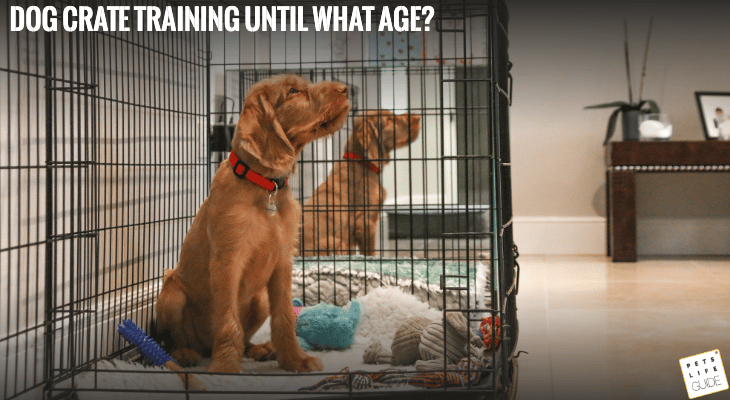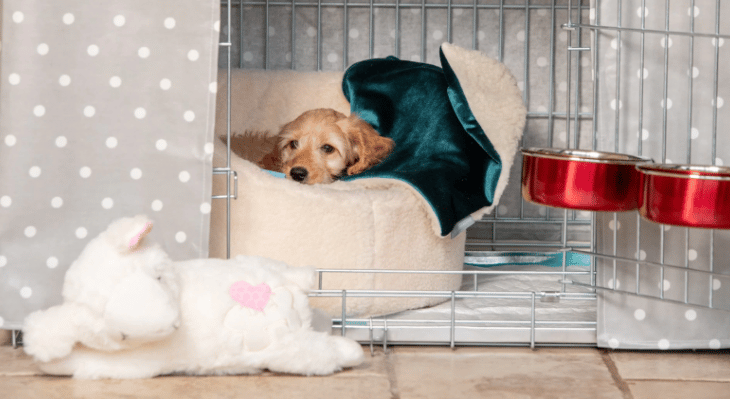Table of Contents
Does Crate Training Ever Stop?
This content will provide helpful tips on crate training a dog, as well as information on what to expect in terms of timeframe and difficulty. The goal is to help understand the process of crate training and why it is important, so that they can be successful in training their own dog.
You’ve just brought home a new puppy and you’re excited to start crate training. But then you start to wonder… how long will this take? When can you stop crate training your dog? Is there an age limit on crate training?
These are all valid questions!
Crate training can be an important part of owning a dog, but it can also be time-consuming and challenging. The age of your dog, their individual personality and breed features, and how they respond to being in a crate will all affect how long it takes to crate train them.
With a little time and patience, you can crate train any dog. But if you’re wondering when to stop crate training, or how long you should keep your dog in a crate, read on for some helpful tips.
One of the most common challenges people face when crate training their dog is not knowing when to stop.
The Target of Any Crate Training
Actually, knowing the final target of crate training makes it easy to understand when to stop and until what age.
A Crate should become a comfortable place for your pup, where he stays at his own will even when it is open
A Few Things to Keep in Mind Deciding When to Stop Crate Training:
- The crate is his little comfy home where a dog can play with his toys or have rest.
- An instrument for behaviour training: At the same time crate is a means to teach your puppy go potty, prevent house destruction, barking or just being at his place when needed. So whenever you reach all these you can stop.
- Your dog’s age: Puppies under six months old may need to be crated for shorter periods of time than older dogs.
- Their individual personality: Some dogs take to crate training quickly, while others may need more time and patience.
- How they respond to being in a crate: If your dog is showing signs of stress or anxiety, he may not be ready to be out of the crate yet.
Benefits of Crate Training as an Important Part of Owning a Dog
As a dog owner, you want what’s best for your furry friend. Part of that is providing them with a safe and comfortable home, which includes crate training. Crate training has many benefits for both you and your dog, including:
- Potty training
A crates helps your dog learn to hold their bladder until they can go outside.
- Establishing a safe space
A crate can provide your dog with a sense of security, especially during times of stress or anxiety.
- Preventing destructive behaviour
If your dog is left unsupervised, they may start chewing on furniture or other household items. Crating them will help prevent this from happening.
- Teaching a dog to travel with you safely
If you are going to take your new family member with you on a road, you should better create for him a habit to travel safe and calm in a crate, in a car or plane.
You may also like
Crate Training a Dog is Worth the Effort
Crate training can be a valuable tool for both you and your dog, but it’s important to be patient and understand that it may take some time for your dog to get used to their crate.
Here are a few things to keep in mind when crate training your dog:
1. Start with short periods of time
When first introducing your dog to their crate, start with short periods of time (e.g., 5-10 minutes) and gradually increase the amount of time they spend in it.
2. Make it a positive experience
Be sure to praise your dog and give them treats when they go into their crate willingly. This will help create a positive association with the crate.
3. Don’t use it as a punishment
Another important thing to keep in mind when crate training your dog is that you should never use the crate as a punishment. This will only make your dog fearful of it and make the training process much more difficult.
If you need to discipline your dog, do so in another way such as verbal correction or removing them from the situation. Then, when they are in their crate, they should only associate it with positive things such as treats or toys.
You may also like
4. The age of a dog matters
One of the things you need to take into account when crate training your dog is their age. Puppies under six months old may need to be crated for shorter periods of time than older dogs. This is because they have smaller bladders and will need to go potty more often. Older dogs, on the other hand, can typically hold their bladder for longer periods of time.
5. The right dog crate size is one of key features
When choosing a crate for your dog, be sure to select one that is the appropriate size. If the crate is too small, your dog may feel cramped and uncomfortable. If it’s too large, they may be able to move around too much and not feel as secure.
A general rule of thumb is to select a crate that is tall enough for your dog to stand up in and wide enough for them to turn around comfortably. Use manufacture’s crate size chart to select a perfect one
A smaller dog may not need as large of a crate as a larger dog. A puppy does not need a crate according to his adult size – a pup can use an empty part of the crate for going potty. If you prefer one crate for all age periods, choose a crate with a divider.
You may also like
6. Crate training takes time and patience
Successfully crate training your dog is a process that will take time and patience. But if you’re consistent with your training and use positive reinforcement, you’ll be able to crate train your dog successfully.
7. Make sure your dog has a comfortable place to sleep
When crate training your dog, it’s important to make sure they have a comfortable place to sleep. This will help them feel more at ease in their crate and make the training process go more smoothly.
You can use a dog bed or mat in their crate, or you can put a blanket down for them to lie on. Just be sure that whatever you use is washable in case of accidents.
You may also like
8. Give your dog plenty of opportunities to get used to their crate
When first starting out with crate training, it’s important to give your dog plenty of opportunities to get used to their crate. This means letting them explore it on their own, without being forced inside.
You can do this by placing their food or crate toys inside the crate and letting them go in on their own. You can also put a treat inside and let them see that it’s okay to go in and get it.
9. Start with short periods of time and gradually increase the amount of time they spend in their crate
Once your dog is comfortable going in and out of their crate, you can start to leave them in there for short periods of time. Start with just a few minutes and gradually increase the amount of time they spend in there.
If they seem to be doing well, you can then start leaving them in their crate for longer periods of time, such as when you go to work or run errands.
Be sure to let them out often enough so that they don’t have to go potty in their crate. Otherwise, they’ll start to associate it with going to the bathroom and it will make the training process much more difficult.
If your pup feels inside the crate really worried, some vets recommend to use calming treat for some time to overcome the anxiety.
Crate training is a process that takes time and patience. But if you’re consistent with your training and use positive reinforcement, you’ll be able to crate train your dog successfully. Just keep in mind that every dog is different, so the training process may take a little longer for some dogs than others.
How Do I Know When My Dog is Ready to Be Out of the Crate?
You’ll know your dog is ready to be out of the crate when they are consistently using it to go to the bathroom and no longer have accidents inside. They should also be comfortable spending longer periods of time in their crate without getting anxious or restless. Once your dog is consistently using their crate and is comfortable spending time in it, you can start to leave them out for longer periods of time. Just be sure to let them out often enough so they don’t have to go potty in their crate.
You may also like
Best Raised Dog Beds for Summer
Questions to Experts
Using positive reinforcement will help your dog associate the crate with good things and make the training process much easier.
Lastly, another mistake people make is letting their dog use the crate as a punishment. The crate should be a positive space for your dog, not a place they're sent to when they're in trouble.
Another thing you can try is using positive reinforcement. Offer your dog treats or toys when they go into their crate and praise them when they come out. This will help them associate the crate with good things.
Lastly, if your dog is still having trouble adjusting to the crate, try contacting a professional trainer for help.
Summary
Crate training is a process that takes time and patience. Some dogs take to crate training instantly, while others may need longer time. It is important to be consistent with your training and use positive reinforcement. You’ll know your dog is ready to be out of the crate when they are consistently using it to go to the bathroom and no longer have accidents inside. They should also be comfortable spending more time in their crate without getting anxious or restless. Once your dog is consistently using their crate and is comfortable spending time in it, you can start to leave them out for longer periods of time. Just be sure to let them out often enough so they don’t have to go potty in their crate.
Always remember – we are here to help you with the right choice. So please do not hesitate to ask any questions and we will answer them right away!






Leave a Reply